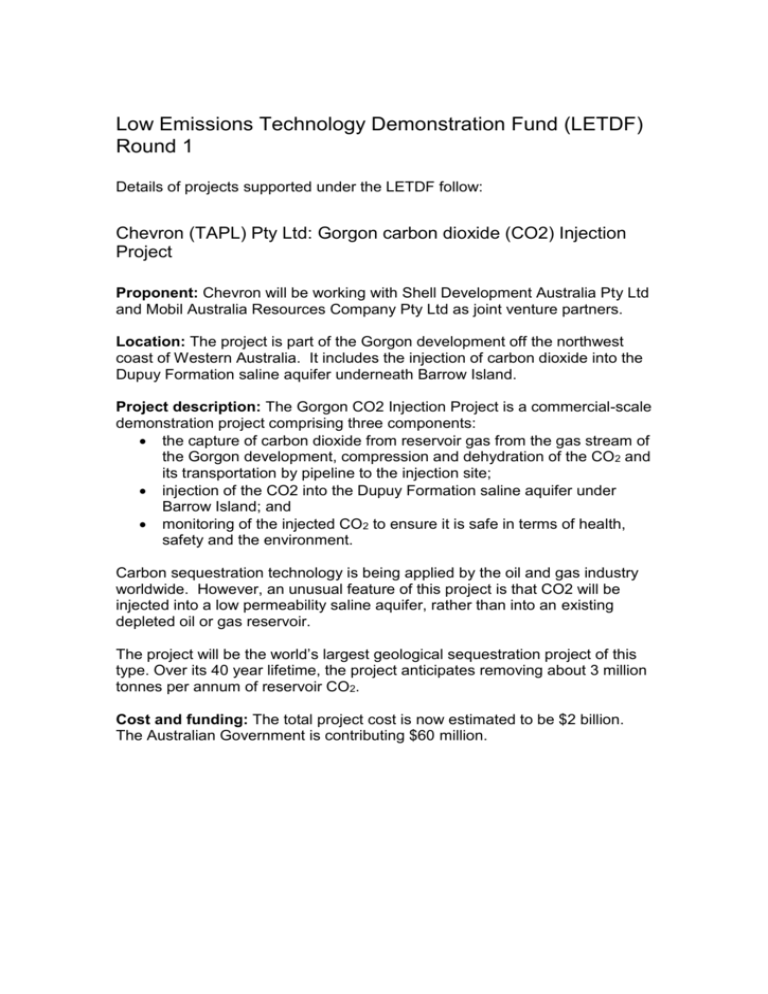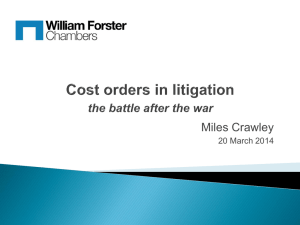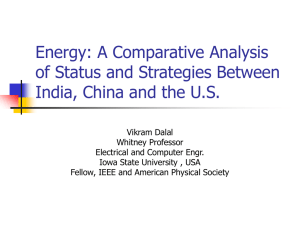Low Emissions Technology Demonstration Fund (LETDF) Round 1
advertisement

Low Emissions Technology Demonstration Fund (LETDF) Round 1 Details of projects supported under the LETDF follow: Chevron (TAPL) Pty Ltd: Gorgon carbon dioxide (CO2) Injection Project Proponent: Chevron will be working with Shell Development Australia Pty Ltd and Mobil Australia Resources Company Pty Ltd as joint venture partners. Location: The project is part of the Gorgon development off the northwest coast of Western Australia. It includes the injection of carbon dioxide into the Dupuy Formation saline aquifer underneath Barrow Island. Project description: The Gorgon CO2 Injection Project is a commercial-scale demonstration project comprising three components: the capture of carbon dioxide from reservoir gas from the gas stream of the Gorgon development, compression and dehydration of the CO2 and its transportation by pipeline to the injection site; injection of the CO2 into the Dupuy Formation saline aquifer under Barrow Island; and monitoring of the injected CO2 to ensure it is safe in terms of health, safety and the environment. Carbon sequestration technology is being applied by the oil and gas industry worldwide. However, an unusual feature of this project is that CO2 will be injected into a low permeability saline aquifer, rather than into an existing depleted oil or gas reservoir. The project will be the world’s largest geological sequestration project of this type. Over its 40 year lifetime, the project anticipates removing about 3 million tonnes per annum of reservoir CO2. Cost and funding: The total project cost is now estimated to be $2 billion. The Australian Government is contributing $60 million. CS Energy: Oxy-firing demonstration and carbon sequestration project (Funding support has been transferred to NLECI) Proponent: CS Energy’s partners in the oxy-firing project are a Japanese consortium comprising JCoal, JPower and IHI; the Australian Coal Association and Xstrata Coal; Schlumberger – a world leader in geosequestration technology; the CO2CRC and the CRC for Coal in Sustainable Development. Location: The project is being implemented using the Callide A power station at Biloela in central Queensland. Project description: CS Energy Ltd. is retrofitting a set of new technologies into an existing coal-fired power station in Queensland. The project involves four processes: - oxygen production; - the use of that oxygen in the oxy-firing of pulverised black coal; - capture of the gases resulting from combustion; and -CO2 separation, liquefaction, transport and geological storage. The demonstration project will store up to 30,000 tonnes of carbon dioxide over three years. As a result of the oxy-firing combustion process, the technology will also reduce emissions of sulphur oxides and nitrogen oxides. This project has already attracted several international partners since it provides an efficient way to deal with emissions from existing coal-fired plants. Construction at Callide A is scheduled to commence in late 2009. Cost and funding: The original project cost was $206 million. The Australian Government is contributing $ 50 million. HRL Limited: 400 MW IDGCC Clean Coal Demonstration Project Proponent: HRL Limited is an unlisted Australian owned energy, technology and project development company. HRL is providing the Integrated Drying & Gasification Combined Cycle (IDGCC) Technology and design. HRL Limited has established a wholly owned subsidiary Dual Gas Pty Ltd to undertake the project. Location: The project demonstration will be implemented in the La Trobe Valley, Victoria. Project description: HRL have developed a new technology for integrated drying and gasification of moist reactive coals, including brown coal, to produce power at a higher efficiency than conventional power plants, with an estimated 30% lower cost of electricity production, 30% less CO2 emissions, and 50% less water consumption. The technology has been proven at the 10 MW scale. This project is aimed at demonstrating the technology at full scale. The original outline of the Demonstration Project comprised the construction and commissioning of a 400 MW combined cycle clean coal power generation plant supplied by 2x200 MW gasifiers using the HRL IDGCC Technology. Dual Gas has announced that it wishes to build a larger 600 MW plant at a cost of approx $1.2 billion. The technology is also suitable for carbon capture, with prospects for CO2 removal prior to combustion. Cost and funding: The total cost of the 400MW project was originally estimated at $750 million. The Australian Government is contributing $100 million and the Victorian Government is contributing an additional $50 million. International Power: Hazelwood 2030 (LETDF Deed was terminated on 15 February 2011) Proponent: International Power (Technologies) Pty Ltd was formed in March 2006 and is a 100% owned subsidiary of International Power (Australia) Holdings Pty Ltd. International Power is a global power generation and desalination company. Its headquarters are in the UK and it trades on the London and New York stock exchanges. Location: The demonstration project was to occur at the Hazelwood power station in the Latrobe Valley, Victoria. Project description: International Power was to introduce and demonstrate technology to dry brown coal that is used as the feedstock for one of the boilers at the Hazelwood power station. The use of dried brown coal would significantly reduce CO2 emitted by the generating unit. Hazelwood has eight generating units and the company was to consider applying the new technology to all units, if the demonstration project was successful. The project was also to include carbon capture and sequestration facilities. International Power was to adapt internationally available technology for brown coal drying and carbon capture to local conditions. This technology was also to be considered for retrofitting to other brown coal plants in the LaTrobe Valley. Cost and funding: The total project cost was originally estimated to be $369 million. The Australian Government was to contribute up to $50 million and the Victorian Government an additional $30 million. Solar Systems Pty Ltd: Large Scale Solar Concentrator Power Project Proponent: The original project proponent Solar Systems Generation Pty Ltd went into liquidation on 19 February 2010 and its assets were acquired by Silex Systems Ltd on 15 March 2010. Solar Systems Pty Ltd (Solar Systems) is the new project proponent and is a wholly owned subsidiary of Silex Systems Ltd. Location: The project will be positioned in North West Victoria. Project description: Solar Systems Pty Ltd has undertaken to build a zeroemissions 154MW solar concentrator power station in North-Western Victoria. It is expected that this will be the biggest and most efficient solar photovoltaic power station in the world. The project involves a new generation of solar power technology called ‘Heliostat Concentrator Photovoltaic’ (HCPV) technology. This technology currently enables 1500 times more electricity generation from photovoltaic cells than the same area of conventional flat plate solar panels. Delivery of the project will also mean significant scale up of manufacturing of high-tech plant components in Australia. A new manufacturing facility will be built for construction of this project and subsequent power stations expected to be ordered from Australia and overseas. Cost and funding: The total project cost was originally estimated to be $420 million. The Australian Government has offered to continue grant support of up to $75 million, and the Victorian State Government another $50 million.







